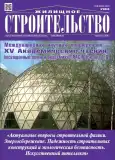Зависимость коэффициентов светопропускания мультифункционального остекления от угла падения излучения
- Авторы: Шубин И.Л.1, Коркина Е.В.1,2, Земцов В.В.1, Кучеров С.С.2
-
Учреждения:
- Научно-исследовательский институт строительной физики РААСН
- Национальный исследовательский Московский государственный строительный университет
- Выпуск: № 6 (2024)
- Страницы: 3-9
- Раздел: СТАТЬИ
- URL: https://gynecology.orscience.ru/0044-4472/article/view/634814
- DOI: https://doi.org/10.31659/0044-4472-2024-6-3-9
- ID: 634814
Цитировать
Полный текст
Аннотация
При эксплуатации зданий со светопрозрачными фасадами повышается нагрузка на систему отопления, вентиляции вследствие трансмиссионных теплопотерь через остекление, а также на систему кондиционирования воздуха вследствие возможного перегрева в летнее время. Поэтому в таких фасадах применяется остек- ление с солнцезащитными, низкоэмиссионными и мультифункциональными покрытиями. Характеристики светопрозрачных ограждающих конструкций, согласно расчетам по нормативным документам, учитываются в расчетах нагрузки на системы отопления, вентиляции и кондиционирования, а также при подборе самих конструкций в заданном климате с целью энергосбережения. При этом характеристики остекления получены в лабораторных условиях при падении излучения по нормали к остеклению, что отличается от натурных условий, когда солнечные лучи падают под углом на остекление. Имеющиеся исследовательские работы по изучению пропускания солнечной радиации, падающей под углом на остекление, основаны на лабораторных исследованиях, когда не могут проявиться и быть учтенными различные физические процессы. В настоящее время в НИИСФ РААСН проводятся исследования по определению эмпирической зависимости коэффициентов светопропускания остекления со специальными покрытиями от угла падения солнечных лучей. В статье приведена часть исследований и рассмотрено определение коэффициента светопропускания остекления с покрытиями и без покрытий в зависимости от угла падения солнечного излучения.
Полный текст
Об авторах
И. Л. Шубин
Научно-исследовательский институт строительной физики РААСН
Автор, ответственный за переписку.
Email: shuig@mail.ru
д-р техн. наук, чл.-корр. РААСН
Россия, 127238, г. Москва, Локомотивный пр., 21Е. В. Коркина
Научно-исследовательский институт строительной физики РААСН; Национальный исследовательский Московский государственный строительный университет
Email: elena.v.korkina@gmail.com
канд. техн. наук
Россия, 127238, г. Москва, Локомотивный пр., 21; 129337, г. Москва, Ярославское ш., 26В. В. Земцов
Научно-исследовательский институт строительной физики РААСН
Email: ins-es@yandex.ru
инженер
Россия, 127238, г. Москва, Локомотивный пр., 21С. С. Кучеров
Национальный исследовательский Московский государственный строительный университет
Email: wysifalay@yandex.ru
инженер
Россия, 129337, г. Москва, Ярославское ш., 26Список литературы
- Дворецкий А.Т., Спиридонов А.В., Шубин И.Л. Низкоэнергетические здания: окна, фасады, солнцезащита, энергоэффективность. М.: Директ-Медиа, 2022. 232 с.
- Щепетков Н.И. Наука о свете в теории и искусстве архитектуры // Архитектура и строительство России. 2022. № 4 (244). С. 60–65.
- Шубин И.Л., Умнякова Н.П., Матвеева И.В., Андрианов К.А. Качество оболочки здания – основа экологически безопасной среды жизнедеятельности // Жилищное строительство. 2019. № 6. С. 10–15. DOI: https://doi.org/10.31659/0044-4472-2019-6-10-15
- Дацюк Т.А., Куренкова А.Ю. Реальная ситуация с обследованием светопрозрачных конструкций в России // Светопрозрачные конструкции. 2020. № 1–2 (129–130). С. 13–15.
- Соловьёв А.К., Дорожкина Е.А. Современное понимание роли естественного освещения при проектировании зданий // Жилищное строительство. 2021. № 11. С. 46–52. DOI: https://doi.org/10.31659/0044-4472-2021-11-46-52
- Спиридонов А.В., Шубин И.Л. Безопасное остекление для «стеклянных» зданий // Архитектура и строительство Омской области. 2021. № 158. С. 44.
- Гагарин В.Г., Коркина Е.В., Тюленев М.Д. Влияние противостоящих зданий на энергосбережение здания с низкоэмиссионным остеклением. // Жилищное строительство. 2022. № 3. C. 30–35. DOI: https://doi.org/10.31659/0044-4472-2022-3-30-35
- Datsyuk T., Leontieva Y., Sokolov A., Mellekh T. Evaluating and ensuring the environmental safety of buildings. Lecture Notes in Civil Engineering. 2023. Vol. 257, pp. 75–84.
- Roos A., Nijnatten P., Hutchins M.G., Polato P., Olive F. and Anderson C. Angular dependent optical properties of lowe and solar control windows – simulations versus measurements. Solar Energy. 2001. No. 69, pp. 15–26.
- Karlsson J., Karlsson B., Roos A. A simple model for assessing the energy performance of windows. Energy and Buildings. 2001. № 33, pp. 641–651.
- Karlsson J. WinSel – a general window selection and energy-rating tool. World Renewable Energy Congress VI. Brighton. 2000. Vol. 594, pp. 2708–2715. DOI: https://doi.org/10.1016/B978-008043865-8/50594-8
- Kupriyanov V., Sedova F. Energy method for calculating insolation of residential apartments. IOP conference series. Materials Science and Engineering. Kazan. 2020. 012038.
- Faye I., Ndiaye A., Mamadou E. Influence of the incidence angle modifier and radiation as a function of the module performance for monocrystalline textured glass and no textured in outdoor exposed. Solar Cells – Theory, Materials and Recent Advances. 2021. DOI: https://doi.org/10.5772/intechopen.96160
- Reber G., Steiner R., Oelhafen P. and Romanyuk A. Angular dependent solar gain for insulating glasses from experimental optical and thermal data. CISBAT Proceedings. EPFL. 2005, pp. 173–178.
- Кондратьев К.Я., Пивоварова З.И., Федорова М.П. Радиационный режим наклонных поверхностей. Л.: Гидрометеоиздат, 1978. 170 с.
- Горбаренко Е.В., Рублев А.Н., Бунина Н.А. Моделирование естественной освещенности в условиях безоблачной атмосферы // Труды Главной геофизической обсерватории им. А.И. Воейкова. 2021. № 603. C. 49–65.
- Коркина Е.В., Шмаров И.А., Гагарин В.Г. Классификация покрытий оконных стекол по светопропусканию // Известия высших учебных заведений. Технология текстильной промышленности. 2017. № 2. С. 118–124.
Дополнительные файлы













